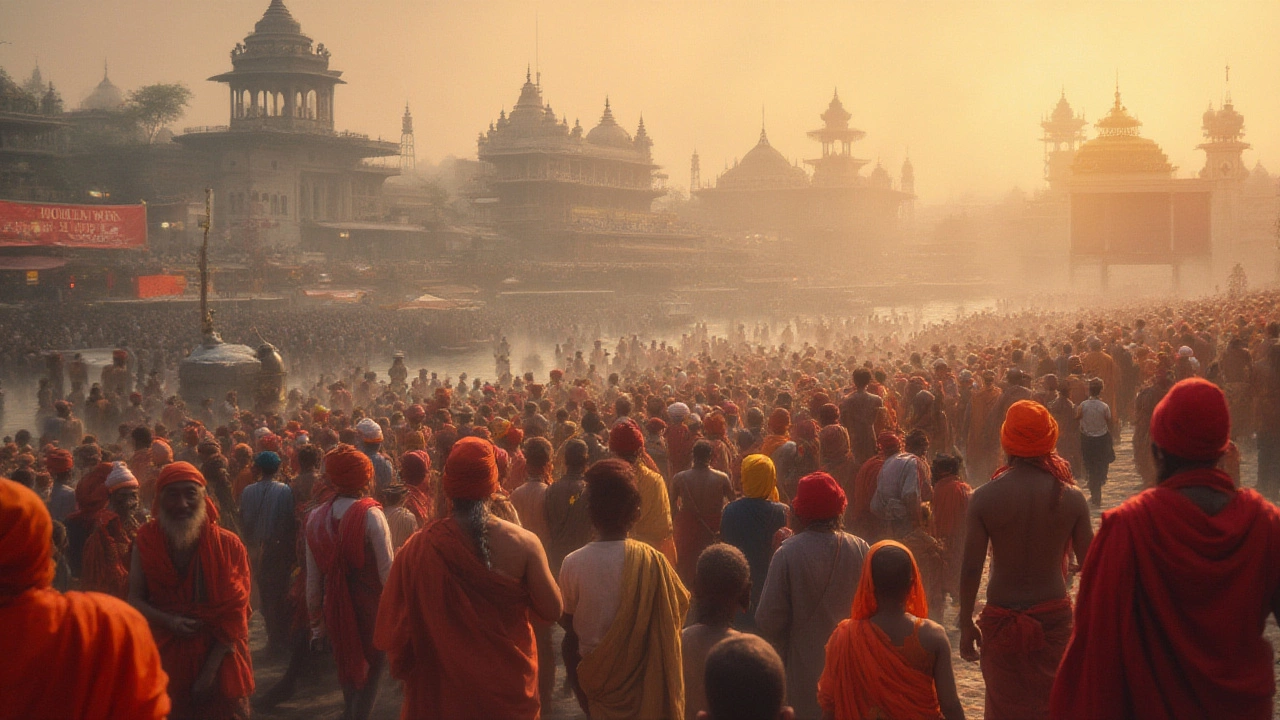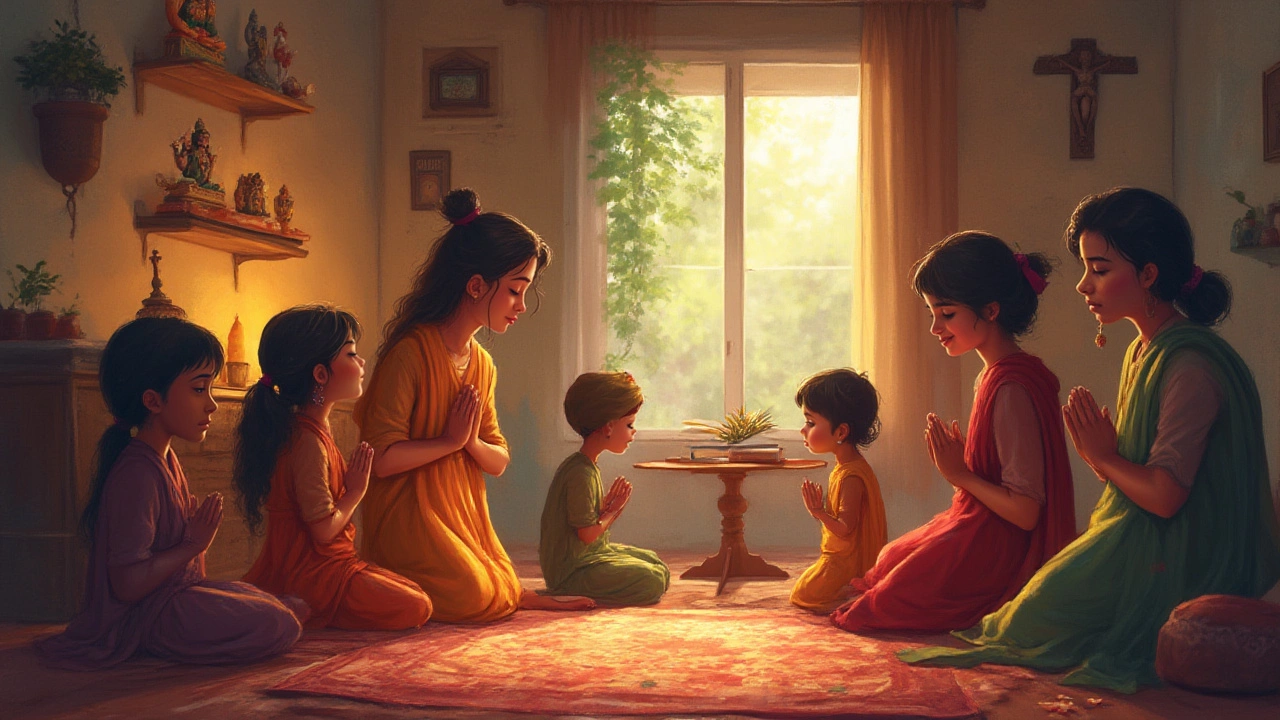Religion in India: Diversity, History, and Modern Insights
 Jul, 30 2025
Jul, 30 2025
Step into a street in Varanasi or Hyderabad, and you might spot a Hindu temple, Islamic mosque, and Christian church all within earshot—each alive with different rituals, music, and that signature cloud of incense smoke. Religion in India isn’t just a private affair or a ticking census box. It shapes streetscapes, calendar dates, even what pops up on your dinner table. Forget the tourist brochures with their neat categories; religion here seeps into life in vivid, unpredictable ways that can surprise even lifelong locals.
India’s Religious Landscape: Where Faiths Collide and Coexist
India isn’t just diverse; it’s the champion of diversity. The 2011 census, which is the last major survey with detailed data, revealed something wild—over 79% of Indians follow Hinduism, making it the spiritual backbone of the country. But pause there. Nearly 15% identify as Muslim, making India home to one of the world’s largest Muslim populations—second only to Indonesia, if you’re counting. Then you’ve got Christianity (about 2.3%), Sikhism (1.7%), Buddhism (0.7%), and Jainism (0.4%). Oh, and don't forget the small but lively Jewish, Zoroastrian (Parsi), Baháʼí, and tribal religion communities. There’s even a smattering of atheists, agnostics, and those who ticked ‘other’. Here’s a breakdown from the 2011 Census:
| Religion | Percentage of Population |
|---|---|
| Hinduism | 79.8% |
| Islam | 14.2% |
| Christianity | 2.3% |
| Sikhism | 1.7% |
| Buddhism | 0.7% |
| Jainism | 0.4% |
| Others | 0.9% |
What really grabs your attention in India isn’t just the numbers—it’s the way religion threads into every bit of daily life. One moment you hear the morning bells from a temple; a few minutes later, the call to prayer from a mosque floats through the air; and on Sunday, church bells ring along with them. Religious festivals overlap in a wild parade of color, music, and food. Neighbors might join each other’s celebrations—Diwali lamps next to Eid biryani and Christmas cakes.
If you’re ever navigating by Google Maps, you might lose count of the mandirs (Hindu temples), masjids (mosques), gurdwaras (Sikh temples), and churches clustered in just a single square kilometer. And don’t get Toby started on the street food during festival season—he’s the only dog I know who’s sampled prasad, halal kababs, and hot cross buns all in one week. This melting pot isn’t always harmonious, but it’s got a resilience most countries would envy.
Looking to visit? Remember that certain regions tilt toward one religion: Punjab pulses with Sikh energy, Kerala boasts a strong Christian legacy, and Ladakh ticks with Buddhist traditions. Uttar Pradesh and Tamil Nadu are famous for their huge, intricate Hindu temples. The variety in ritual, dress, and language can turn even a short stroll into a crash course in the world’s religions.
Hinduism: Colorful Rituals and Ancient Roots
You can’t talk about religion in India and skip Hinduism. Most folks will tell you it’s less of a strict faith and more of an evolving way of life—there’s even a phrase, “Sanatan Dharma,” to cover all its bases. Hinduism’s old, older than written history. The Vedas, their key texts, date back over 3,000 years. Those stories you read about gods riding tigers, blue-skinned Krishna dancing with the gopis, Shiva meditating on a snowy peak—they’re alive here, turning up in temple murals, street art, and Bollywood charts alike.
Wander into a Hindu household, and you might spot a family altar with fresh flowers, little brass lamps, and photos of deities. Daily worship can involve incense, chanting, and offerings—sometimes just fruit or sweets. Ever see professors, rickshaw pullers, and office workers with colorful tilaks (forehead marks)? That’s a common sight on festival mornings or after temple visits. Speaking of festivals, Diwali’s famous, lighting up the country with millions of oil lamps. But don’t miss Holi (where colors fly), Navratri (nine nights of wild dancing), or Ganesh Chaturthi (huge elephant statues everywhere).
The sacred Ganga (Ganges) river, worshipped as a goddess, draws millions for ritual bathing. Each city along the riverbank, from Rishikesh to Kolkata, has its own traditions. And there’s the Kumbh Mela—arguably the world’s largest religious gathering, which saw about 50 million people at Prayagraj alone in 2013. Pilgrimages like this are serious business. Many plan their entire lives around making at least one trip to places like Varanasi, Tirupati, or the southern temples of Madurai and Rameshwaram.
Hinduism’s not just temples and mantras—it influences art, music, and food. Temple architecture changes dramatically by region: Orissa’s jagged towers look nothing like Tamil Nadu’s elaborate, color-clad gopurams. Even the way folks celebrate the same festival shifts from state to state. It’s this fluidity and playfulness that’s kept Hinduism thriving through millennia of change.
But the history isn’t all brightness. Caste—the ancient social structure still visible in villages and power corridors—has roots in Hindu tradition. While reforms and the constitution outlaw discrimination, you’ll spot its legacy if you scratch the surface. Movements from inside the faith, like those led by Swami Vivekananda and Mahatma Gandhi, have worked to open temples and break down barriers. Yet, as you travel, you’ll notice both progress and problems walking side by side.

Islam, Christianity, Sikhism, Buddhism, and More: A Mosaic of Indian Faiths
If you thought India was only about Hinduism, think again. The country’s second-largest faith group is Islam. Introduced over a thousand years ago through traders and later conquerors, Islam settled quickly and deeply. India’s mosques, like Delhi’s Jama Masjid, pulse with the sound of prayer five times a day. Hijabs, skull caps, and the aroma of biryani or kebabs become part of neighborhood life during festivals like Eid-Ul-Fitr or Muharram. Some regions, especially Kashmir, Uttar Pradesh, and West Bengal, have major Muslim populations and their own distinct traditions.
Christianity has roots stretching back to about 52 CE, when St. Thomas is said to have landed on the Malabar Coast. Kerala’s old churches blend local and European art—imagine coconut palms outside with stained glass windows inside. Christmas here is less about snow and more about vibrant processions, roasted meats, and coconut-based sweets. Areas like Goa, Northeast India, and parts of South India have large Christian communities, each celebrating in unique styles.
Sikhism, born in Punjab in the 15th century, focuses on the teachings of Guru Nanak and later Gurus. The Golden Temple in Amritsar is both an architectural wonder and a symbol of Sikh generosity—its langar (free community meal) serves up to 100,000 people daily, everyone welcome. If you ever queue up for that meal, you’ll realize hospitality and service are at the very core of Sikh faith. The distinctive turbans, unshorn hair, and powerful devotional music add a unique flavor to India’s cultural menu.
Buddhism actually began in India, even though you’ll now find more Buddhists in countries like Thailand and Sri Lanka. Bodh Gaya, where the Buddha is said to have attained enlightenment, attracts seekers from every continent. Tibetan Buddhist communities, especially in the Himalayas and areas like Dharamshala, keep the tradition alive and vibrant.
Jainism, another ancient Indian religion, emphasizes non-violence to an extreme—some Jain monks even sweep the ground ahead of them to avoid stepping on insects. Jain temples sparkle with marble and intricate carvings, and cities like Palitana or Shravanabelagola become pilgrimage sites for Jains from around the world. Their vegetarian cuisine, which is strict even by Indian standards, might surprise you with its creativity.
Beyond the big six, communities like the Parsis (Zoroastrians), Jews, Baháʼís, and tribal faiths hold their own festivals and traditions. Parsis, for instance, are famous for their fire temples and their tiny but influential community in Mumbai. They invented some of India’s quirkiest breakfasts—ever tried dhansak or berry pulao? The Baháʼí Lotus Temple stands in Delhi, welcoming visitors from all backgrounds, and tribal religions in the northeast and central India still practice rituals that predate written history.
Modern Shifts: Secularism, Mixes, and the Everyday Puzzle
India’s constitution calls it a secular republic, technically separating religion from state actions. Yet, step outside the law books, and you’ll see faith weaving into politics, education, and pop culture. Laws around marriage, inheritance, and adoption can change depending on your religion. Political leaders often attend a cross-section of festivals—part spiritual, part social strategy.
Interfaith friendships, marriages, and workplaces are everywhere, especially in cities. The urban young, in places like Bengaluru or Mumbai, might celebrate Diwali in the same week they go to a Christmas party or eat haleem at a Ramadan dastarkhwan. Bollywood movies toss in scenes from every major festival. Some families blend faiths—my neighbor has a temple room and a Christmas tree, and no one finds it weird.
But religious coexistence takes real work. India does see tension and even violence between communities at times. News headlines sometimes focus on flare-ups, but that’s not the whole story. There’s a quiet, constant negotiation going on—neighbors learning about each other’s boundaries, businesses taking holidays that match local festivals, schools organizing multi-faith assemblies. Kids in many public schools learn respect for all faiths as part of the curriculum. Tips for travelers: Dress conservatively near places of worship, avoid taking photos where signs say so (especially inside mosques or near prayer areas), and never enter someone’s sacred space with shoes on.
You might wonder how everyone keeps track of so many holy days. The answer? It’s not easy! Schools often have multiple closures for Diwali, Eid, and Christmas. Workplaces offer ‘restricted holidays’—days off you can take for your particular festival. This patchwork approach means the calendar’s always bustling with some live tradition or fast, from Shravan (the monsoon month of fasting for Hindus) to the Muslim holy month of Ramadan.
Technology is blending faiths in new ways too. WhatsApp groups buzz with festival greetings, and more worship happens online—a trend kicked into top gear during the COVID-19 pandemic. Apps for reading scriptures, tracking festival dates, and even donating to temples or mosques? Yes, those exist. My mom tracks her puja times with an app, and Toby’s vet closes on Good Friday, Eid, and Diwali, so we basically celebrate everything whether we mean to or not.
Big picture: Indian religion is messy, creative, sometimes contradictory, but mostly built on layers of daily negotiation and shared traditions. Whether you’re an armchair traveler or planning your first trip, it’s best to bring flexible expectations, curiosity, and a hearty appetite for both stories and sweets. If you want tips: always double-check festival dates before journeys, make time for at least one community meal (like a gurdwara langar or temple prasad), and stay open to having your assumptions pleasantly upended. That’s religion in India—a wild, colorful, ever-changing ride no guidebook could capture in neat, tidy lines.